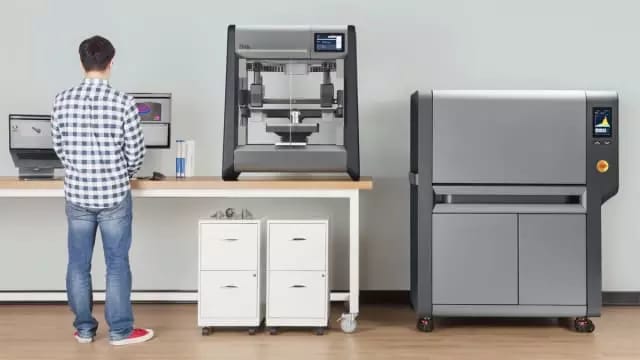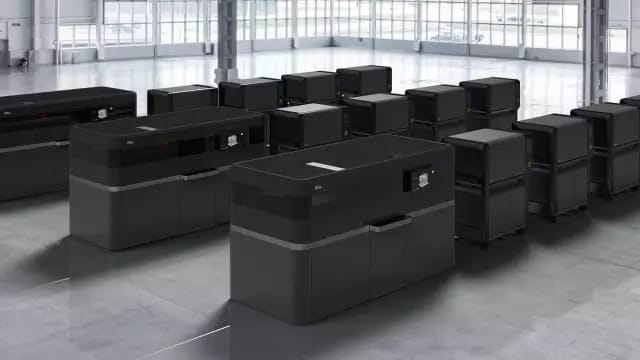
Ahead of RAPID+TCT 2017, an exciting startup known as Desktop Metal finally came out of stealth mode after almost two years to reveal not one, but two new additive manufacturing (AM) technologies.
Even before the big unveil, the startup’s technology received a hefty vote of confidence in the form of $97 million in funding raised from GV (formerly Google Ventures), the BMW Group, Lowe’s, GE, Saudi Aramco, Lux Capital, Stratasys, NEA and Kleiner Perkins Caufield & Byers.
To learn more about the new systems showcased at RAPID+TCT, ENGINEERING.com spoke to Jonah Myerberg, cofounder and chief technology officer of Desktop Metal.
Founding Desktop Metal
Myerberg has been working with cofounder and CEO of Desktop Metal RicFulop since 2005, when he joined Fulop’s lithium battery company A123Systems. While Myerberg continued in batteries, Fulop entered the world of venture capital, funding and sitting on the boards of a number of startups that readers will be familiar with, including Proto Labs, Onshape and Markforged.
“He was really exploring this space of 3D printing and AM, but also 3D modeling,” Myerberg said.“He saw a lot of demand for metal 3D printing in his investments, but he didn’t see a lot of people entering the market with any really good technology. So, the two of us kicked around the idea of a better way of printing metal parts. What we saw when we looked at metal 3D printing in 2014 and 2015 was an intention to scale a powder bed process into mass, put more lasers on the machine and make it go faster. There wasn’t new technology coming out, and we weren’t convinced that a laser powder bed was the answer.”
In 2014, Myerberg and Fulop began exploring new processes for metal 3D printing and came across five or six different technologies that could be viable. Three months later, those options were whittled down to what would eventually become the company’s core technologies.
Desktop Metal was founded in 2015 and recruited a number of material scientists and other engineers from MIT.By May of this year, the company had raised $97 million and was ready to unveil the Studio and Production Systems.
From Metal Rapid Prototyping to Metal AM
The DM Studio System is designed for safe metal rapid prototyping in the office or shop. With a price of $120,000, it’s is much less expensive than industrial powder bed fusion systems.
Rather than using expensive, high-powered lasers, the DM Studio System relies on what Desktop Metal dubs Bound Metal Deposition (BMD). BMD sees metal powder bound in a plastic matrix melted and deposited onto a print bed in a method similar to fused filament fabrication (FFF) or fused deposition modeling.
The DM Production System, as one might guess from the title, is for batch production of metal parts. It is expected to cost around $360,000, with additional equipment pricing to be determined, and is described as being 100 times faster than powder bed fusion technologies. It achieves this through the use of Single Pass Jetting, in which an inkjet print head deposits a binder onto a bed of metal powder and heats it in a single pass so that, with each move of the print head, another layer of a build job is made.

Once printed, parts made on either the Studio or Production systems are placed into a microwave-enhanced furnace created by Desktop Metal. By printing an interface layer using a specialty agent, the sintered parts can be removed from their support structures by hand, meaning that no cutting tools are required.
The two technologies are complimentary, according to Myerberg. Engineers are meant to be able to both rapidly prototype with AM and then manufacture with AM, as well. “Our vision was that we would allow engineers to do something that they’ve never been able to do before: Design for additive, prototype in additive and then head to production in additive. This has been the promise of AM, but there really hasn’t been a way for them to do it.”
Thanks to dropping costs in FFF, it’s possible for engineers to prototype rapidly in plastic using a machine that can cost a few hundred or a few thousand dollars. Until recently, not only has metal 3D printing not been available at the desktop level before, but mass manufacturing with metal AM has also been very difficult to come by.
That means that, even if a metal prototype were 3Dprinted, engineers would still have to tailor their designs for a specific mass manufacturing technique, such as injection molding or stamping. As a result, none of the advantages possible with 3D printing, such as geometric complexity, could actually be implemented in a mass-produced part.
Read more at ENGINEERING.com

